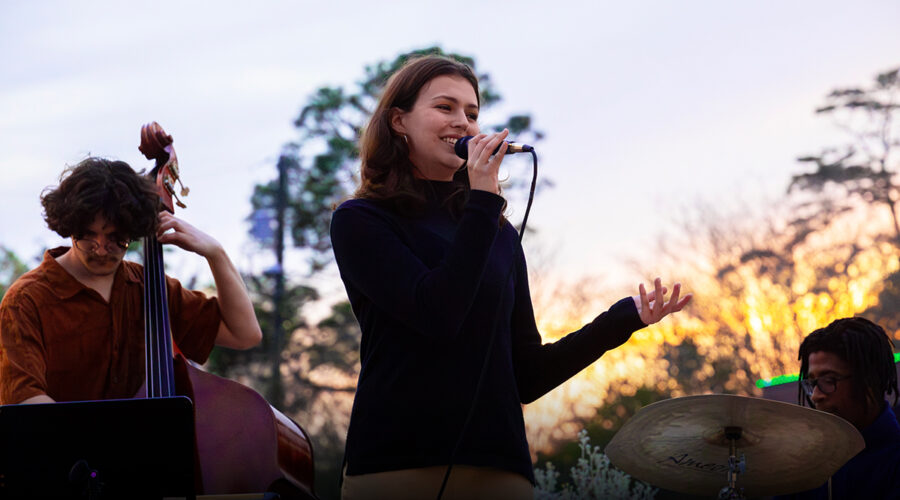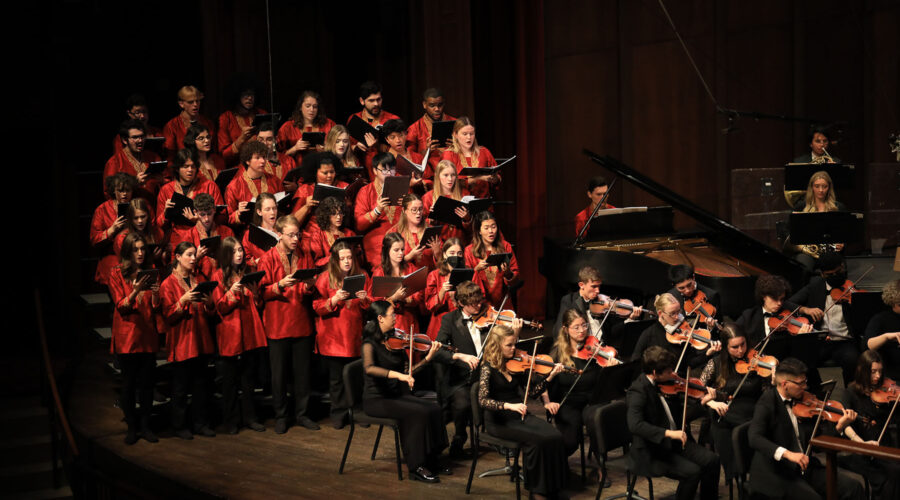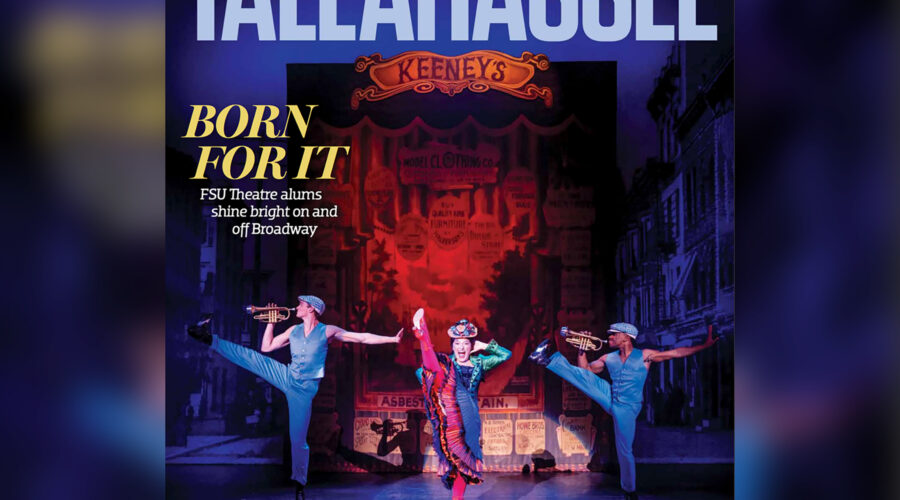Autograph: The Music Special Collections Blog of the Warren D. Allen Music Library

Scrapbook 17: An Unassuming Primary Source and an Exercise in Layered Readings
Guest Post by Susan Evans, Ph.D. Student, Musicology, Florida State University
This post is an adaptation of a paper composed for an Archives seminar class at FSU with Dr. Maria Ryan in the Spring of 2022. The original paper is titled, “An Unexpected Turn: The Legacy of Charlotte Cooper in the Scrapbook Pages of Another.”
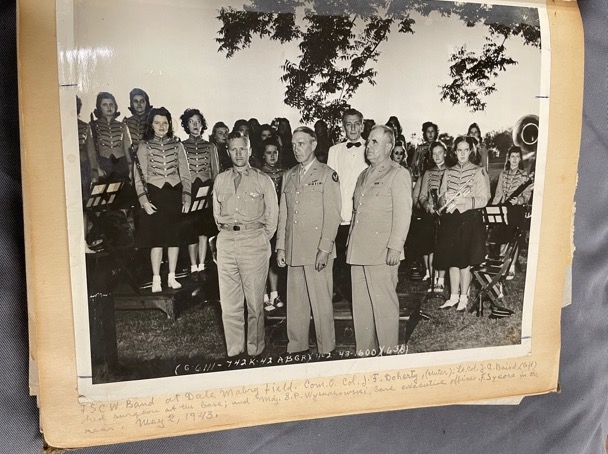
Florida State College for Women Band
“Scrapbooks can also have a “discursive profile” which when placed in dialogue with other written histories can offer a different perspective and in some cases, provide remediation of existing narratives…”
In this photo: Florida State College for Women Band conductor Frank Sykora (faculty member) in white jacket, and visiting members of the Armed Forces at Dale Mabry Air Field ( left to right: Lt Col Joseph A Baird, Col James F Doherty and Maj Edward P Wyruchowski. The students are not identified.
My encounter with Scrapbook 17 was purely serendipitous. While searching the Allen Music Library’s special collections resources for an item to call up for a class visit to the archives, I happened upon the College of Music Historical Scrapbooks Collection and its finding aid. It was there that I discovered that I might be able to locate a scrapbook containing references to Charlotte Cooper in an effort to learn more about her and the band that she helped to organize during her time as a student at the Florida State College for Women. What I learned from the contents of Scrapbook 17 not only provided significant insights into her legacy, but also revealed the value of a scrapbook to research.
This scrapbook is part of a collection composed of 39 volumes that cover over 100 years of College of Music History, dating from its early days as the Florida State College for Women. The condition of the once clothbound book is fair and its delicate pages are filled with newspaper and magazine clippings, programs, personal letters, photographs and band personnel rosters. The scrapbook is not complete however, as there are empty pages at the back of the book that display only document headings as well as a file folder which contains several loose documents. My attribution of this scrapbook to former faculty member Frank Sykora forms part of a larger discourse which emerged from time spent with this item.
When compiling a list of potential primary source materials on a given subject, a scrapbook might not be an intuitive choice, in part because of its ephemeral nature. This is evident not only from my own lack of prior consideration of such a source but also from its absence as a primary source from two recent publications whose discussions of the Florida State College for Women’s marching band may have benefited from this item’s contents.[1] Through my readings of what I believe to be Frank Sykora’s scrapbook of his time on faculty at the Florida State College for Women in the mid 1940’s. I have discovered that a scrapbook is incredibly valuable as a primary source and that it provides at least three “profiles” through which to interpret its contents.
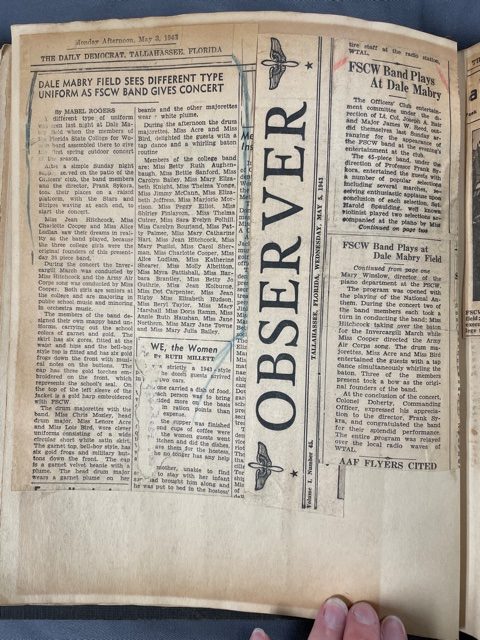
Press clippings from Scrapbook 17
The first of these profiles is the “creator profile” and initially involves taking stock of the contents to determine authorship. The various thank you notes and job offers addressed to Frank Sykora in Scrapbook 17 provide compelling evidence that he is the likely author. This, in conjunction with the finding aid entry “a gift from Frank Sykora(?)”, further supports Sykora as its creator. [1] The items collected for the scrapbook and their physical placement further defines the “creator profile.” For example, Frank Sykora saved photographs of the founding members of the marching band, including Charlotte Cooper’s, and placed them opposite a thank you note signed by these same members. This signifies the importance of these items and their subjects to their compiler. The physical proximity of these items in the scrapbook to one another also suggests a desire by Sykora to remember the impact of these individuals and his relationship to them as a band director.
These chosen items and their proximity to one another can also be used to establish a “narrative profile.” The “narrative profile” provides insight into the stories that can be told about a person’s history or broader historical narrative based on how the scrapbook items interact with one another. One instance of this is a grouping in Sykora’s scrapbook of three separate clippings from local newspaper articles that mention two of the band’s founding members, Charlotte Cooper and Jean Hitchcolk, as conductors on a concert that was broadcast from the Dale Mabry Air Base in Tallahassee.[2] The proximity of these articles to one another makes for an easy comparison of their content, namely, the mention in all three publications of female conductor’s by name on the concert. This contributes to a greater historical narrative of conducting opportunities for women in the 1940’s. Additionally, their mention by all three publications by name and without explicit reference to gender is a treatment that could be compared to contemporary press coverage of female conductors.
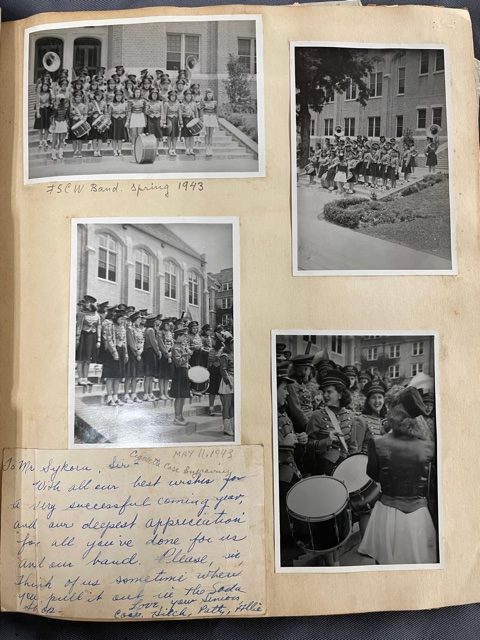
Scrapbooks can also have a “discursive profile” which when placed in dialogue with other written histories can offer a different perspective and in some cases, provide remediation of existing narratives. The Florida State College for Women and Frank Sykora are both mentioned in Amy E. Spears and Jill M. Sullivan’s chapter “All-Female School Bands: Separate Spheres and Gender Equality” in Women’s Bands in America. In their consultation of a primary source for this chapter, a Florida State College for Women yearbook, Sullivan and Spears observe that “In biographical descriptions of the college women in the school yearbook, one bandwoman was featured, and her photo shows her in a band uniform.”[3] However, the photograph (of co-founding member Alice “Allie” Ludlam) referenced here is not the only bandwoman to be featured in this section of the yearbook.
Charlotte Cooper and Jean Hitchcolk are given credit on the page dedicated to band membership in the yearbook consulted by Sullivan and Spears as founding members, though they are not located by the authors in the full-page student feature section alongside Alice Ludlam. This may have been the case with Cooper as her photograph shows her holding a violin, not the French Horn that she played in the marching band.[4] In the description under her photo in the yearbook it distinctly says, “Besides playing Emma, she plays in the band which she helped to organize during her freshman year.”[5] A consultation of Scrapbook 17 would have provided the authors with images of Cooper and Hitchcolk that referenced their connection to the marching band. This in turn may have led them to locating their photographs in the feature section of the yearbook which could then have resulted in a narrative that credits Cooper and Hitcholk with helping to establish the first marching band at the Florida State College for Women.
In all fairness to Sullivan and Spears, consultation assumes access. Since many scrapbooks are fragile and naturally the only copy in existence, researchers are bound to an institution’s policies regarding the viewing and handling of these items which may require an in- person visit. A move towards digitizing scrapbooks to increase access would require significant labor and costs but would facilitate a means to materials whose contents provide valuable insights unique to this medium. Scrapbook 17, an item happened upon accidentally, became central to understanding not only the history of the Florida State College for Women’s marching band and the legacies of Frank Sykora and Charlotte Cooper but also revealed the tripartite value of scrapbooks to scholarly research.
Note: “Scrapbook 17″ resides in special collections in the Warren D. Allen Music Library at Florida State University. This item forms part of a larger ” Historical Scrapbook Collection” which serves to document the history of the Florida State College of Music.
Bibliography
College of Music. “Collection Inventory.” College of Music Scrapbooks. Accessed, April 8, 2022. https://music.fsu.edu/library/specialcollections/scrapbooks.
Faucett, Bill F. The Marching Chiefs of Florida State University: The Band That Never Lost a Halftime Show. North Carolina: McFarland, 2018. https://search-ebscohost- com.proxy.lib.fsu.edu/login.aspx?direct=true&db=nlebk&AN=1637030&site=ehost-live.
Flastacowo, 1943. Florida State University Yearbooks, Heritage & University Archives. FSU Digital Library. http://purl.flvc.org/fsu/fd/FSUYB_1947 Accessed April 28, 2022.
Florida Flambeau, December 13, 1940. Heritage & University Archives, FSU Digital Library. http://purl.flvc.org/fsu/fd/FSU_Flambeau_12131940 Accessed February 27, 2022.
Scrapbook 17, 1942-1947, 17. College of Music Historical Scrapbooks Collection, FSUML- 2020-024. Allen Music Library Special Collections. https://archives.lib.fsu.edu/repositories/12/archival_objects/190554.
Sullivan, Jill M. Women’s Bands in America: Performing Music and Gender. Lanham, Maryland: Rowman & Littlefield, 2017.
About the Author
Susan Evans, (B.Mus., B.Ed., M.M. Wind Conducting) is a second year Ph.D. student in Musicology at Florida State University where she also teaches undergraduate music history courses. Her research interests include the wind band, radio programming trends, Alan Hovhaness and extracting stories from seemingly insignificant details.
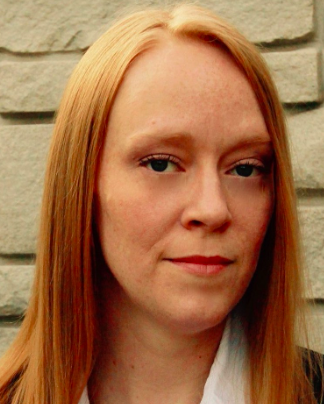
About the blog
Autograph is a research blog dedicated to showcasing both the scholarship of our musical community at FSU and the holdings of our music special collections at the Warren D. Allen Music Library, Florida State University.
If you are a faculty member, student, or staff member who would like to submit writing for consideration, please contact Dr. Arianne Johnson Quinn, Music Special Collections Librarian at AMLSpec@fsu.edu.
End notes
[1] “Collection Inventory,” College of Music Scrapbooks, College of Music, accessed, April 8, 2022, https://music.fsu.edu/library/specialcollections/scrapbooks.
[2] Anonymous, “Band Will Give Concert.” The Florida Flambeau. April 30, 1943 Scrapbook 17, 1942-1947, fol. 4r., College of Music Scrapbooks, Warren D. Allen Music Library, Tallahassee, Florida. http://purl.fcla.edu/fsu/FSUML-2020-, and Mabel Rogers, “Dale Mabry Field Sees Different Type Uniform as FSCW Band Gives Concert.” May 3, 1943, Scrapbook 17, 1942-1947, fol. 4v., College of Music Scrapbooks, Warren D. Allen Music Library, Tallahassee, Florida. http://purl.fcla.edu/fsu/FSUML-2020- and Observer, “FSCW Band Plays at Dale Mabry.” May 5, 1943, Scrapbook 17, 1942-1947, fol. 4v., College of Music Scrapbooks, Warren D. Allen Music Library, Tallahassee, Florida. http://purl.fcla.edu/fsu/FSUML-2020-.
[3] Jill M. Sullivan and Amy E. Spears, “All-Female School Bands: Separate Spheres and Gender Equality,” in Women’s Bands in America, ed. Jill M. Sullivan (London: Rowman & Littlefield, 2017), 115.
[4] Sullivan, Spears, “All-Female School Bands: Separate Spheres and Gender Equality,” 118.
[5] Flastacowo, 1943, Florida State University Yearbooks, Heritage & University Archives, FSU Digital Library, http://purl.flvc.org/fsu/fd/FSUYB_1947, accessed April 28, 2022., 121.
[1] Publications that may have benefited from Scrapbook 17’s contents Bill F. Faucett, The Marching Chiefs of Florida State University: The Band That Never Lost a Halftime Show, (North Carolina: McFarland, 2018), 212, https://search-ebscohostcom.proxy.lib.fsu.edu/login.aspx?direct=true&db=nlebk&AN=1637030&site=ehost-live. and Jill M. Sullivan and Amy E. Spears, “All-Female School Bands: Separate Spheres and Gender Equality,” in Women’s Bands in America, ed. Jill M. Sullivan (London: Rowman & Littlefield, 2017).
